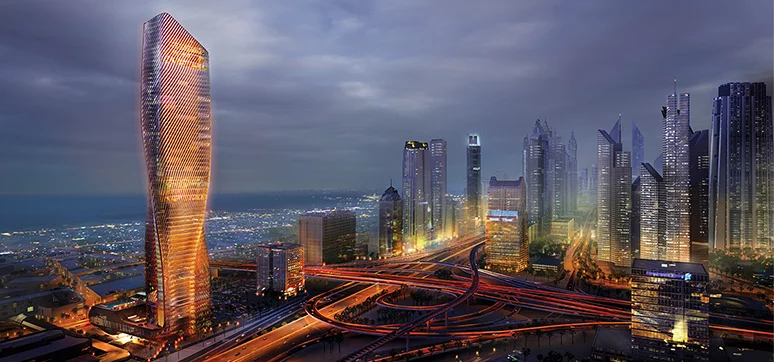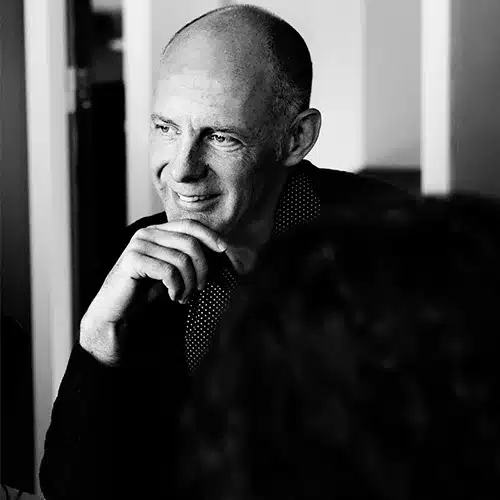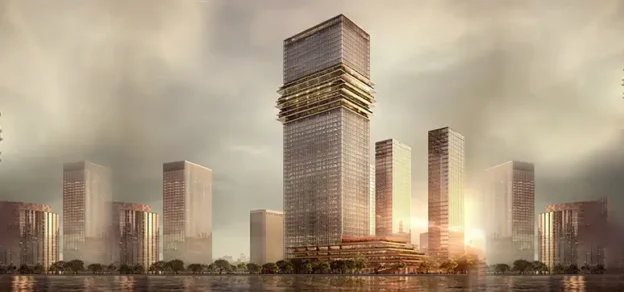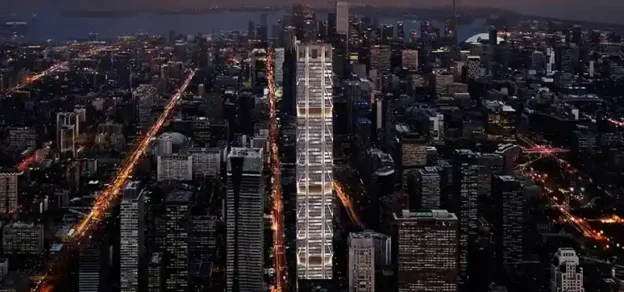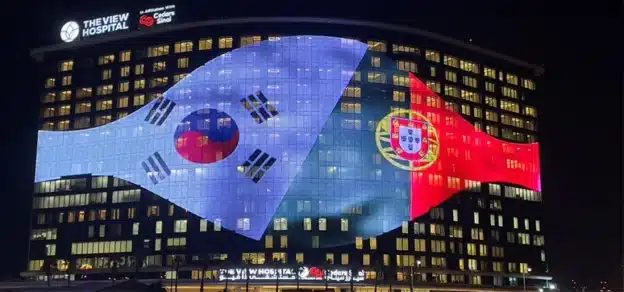A New Kind Of High-Rise For Dubai
In 2013, UNStudio, in collaboration with Werner Sobek, was invited by the wasl Development Group to design a new kind of high-rise for the city of Dubai that would act as a benchmark for both the region and for the wasl Development Group itself. The project is located in an exceptional central position in Dubai’s network – along Sheikh Zayed Road, the main thoroughfare that connects the Emirates north to south – and directly opposite the Burj Khalifa and when completed will be one of the world’s tallest ceramic façades.
Dubai’s reputation as a transfer hub is rapidly transforming into one of a long stay destination, especially during the cooler winter months. The city also enjoys an impressive infrastructure. When arriving at night by plane or car, it resembles an ever-evolving organism in the dark desert – connecting places, people and culture. The ambition for the wasl Tower is to create a timelessly crafted icon within Dubai’s skyline, that would match the city’s drive to develop a world renowned architecture that should be prepared for the new century and provide a benchmark for other projects in the region.
The design concept for wasl Tower – a slender 300-meter tall super-high-rise – is to partially share with the public a typically private architectural typology (that of the tower), at certain programmatic moments throughout the structure. This approach was informed by the Tower’s location, at one of the city’s key public transportation network junctions, that enjoys access to the metro line, pedestrian walkways to the city centre and connection vehicular routes. The design of the tower reflects the notion of these connections. Adopting a classic ‘contrapposto’ movement, the mixed-use tower faces in almost every direction, allowing the profile of the building to constantly change, regardless of where it is viewed in the city, while also offering public areas high up in the building.

The wasl Tower comprises a substantial mixed-use programme consisting of offices, residential spaces, and a hotel, in addition to public areas where the typologies overlap. These comprise four public lobby spaces: a ground floor lobby, a spa lobby that connects the tower and car parking, roof and pool area, a sky lobby at 130m and a rooftop lobby.
Taking Cultural Sustainability, Health And Innovation To The Next Level

As the project strongly relates to and interconnects with Dubai’s urban experience, the aim is to make a visit to the wasl Tower as attractive and contemporary as possible. As such a dedicated concept of health, comfort and well-being throughout was developed for the building. UNStudio’s design is closely interlinked with the engineering and sustainability concept developed by Werner Sobek. This close cooperation defines scale, light, building physics and materialisation.
Also, smart access, communication and security, provide a seamless technological base which integrates with the architecture. Clean materials, interactive light levels, in addition to good acoustics are implemented in all spaces throughout the building. Particularly on the public levels, when combined with a specific food experience, hosting and aesthetics, they will result in a seductive activation of the human senses. In consultation with the client, clay was chosen as a basic material, as such the façade fins will be manufactured as low-tech glazed ceramic elements.
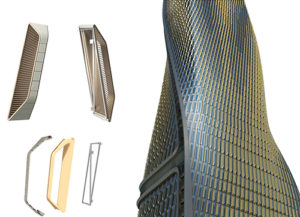
The wasl Tower has a 360-degree façade that is built up in layers. To reduce the heat load, the outer zone of the tower was developed with the orientation of the sun as a guiding principle. By adding a veiled skin around the façade, it became possible to include additional shading elements and reduce the cooling load by approximately 25% in relation to older high-rises in the city, and bring daylight deep into the building. This outer zone makes use of a local product and is clad in thousands of solar shading fins made of resilient clay fired ceramic tiles. The ceramic is glazed with a metallic finish to create a patina that can withstand 50-100 years of sun, wind, sand and salty humidity.
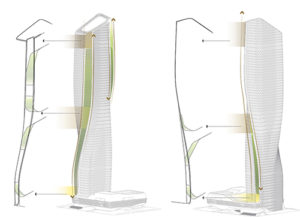
However, to be used in a high-rise, this glazed clay had to be reinvented. The danger of chipping and falling, along with costs, were intensively researched with suppliers. Benchmarking was also carried out in other locations. For the fins, which sit on top of the façade in 3D, it was determined that only the face that is oriented to the outside should be used. The cavity created between the façade and the outside face ensures that the heat is absorbed by the clay and cooled down by the air around it.
One side of the fin also has an open aluminium grill which enhances this effect. The sun substantially affects the appearance of the building. The sheen of the ceramic glaze causes the building to subtly change throughout the day, as the unitised façade is opaque and transparent depending on the orientation. With the façade engineer Werner Sobek, a shading pattern was established that enabled highly transparent glazing to be used throughout the tower. The inner zone of the façade provides a connection to all of the interiors.
The geometry of the tower achieved its holistic appearance using innovative parametric design and high-tech engineering. The available sustainable measures required in the broader region have been seamlessly implemented into the design. With the client, we defined additional measures for sustainability, such as the use of ©Plompmozes district cooling, grey-water recycling and the use of PV, which is integrated into the parking building, to provide energy for the lighting of the façade. In addition to this, we concentrated on the health and well-being of the guests and residents.

Werner Sobek and UNStudio composed a protocol for the use of clean materials and finishes that enhances comfort and user experience throughout the project’s interior. With technology and a clear spatial setup, we also make sure that people can find their way throughout the project and orientate themselves easily. These measures, in addition to a precise planning of public levels and group amenities, make the project highly socially sustainable.
Vertical Boulevard

The open seam that runs the full height of the tower forms a ‘vertical boulevard’, which is topped by infinity pools on the tower roof. This seam is created by a stacking of outdoor balconies and forms a green vein, which also affords a glimpse of the interior of the building. The boulevard connects the outdoor to the indoor and is a unique feature of the region.
The ceramic fins not only serve as a solar heat reflectance mechanism that shields the building façade against the harsh desert sun, but they also are the source of the LED lighting system, that was developed with Arup Lighting, and that will activate during the evening hours. The rhythmic, pulsating of the LED façade lighting system drew attention to the tower in an ephemeral manner without casting additional ambient light pollution into the already active skyline. This façade lighting is powered by the energy cube PV panels located on the car park building.

The inside of the tower is equally sustainable. The mixed-use programme, comprising offices, guest rooms, public areas, and apartments, presented a challenging core configuration. A smart structural concept – with three 300 metre high shear walls in the core that connect 4 large outriggers on strategic levels – gives the tower an almost free, highly efficient floorplate. Meanwhile, a vertical transport strategy is implemented to facilitate separate access to the various programmes. Three high-speed express lifts connect the four main lobbies (ground/spa/ sky and rooftop) which contain most of the public programme and the main access to the hotel (at 150 metres). Four offices and four guestroom lifts share the same lift shaft, while the residential apartments on the higher levels have their designated lift-group, making direct access via the basement parking possible. In total the building provides 17 lifts, of which 5 are service elevators.
The tower is supported by a low rise carpark building which, uniquely, also houses a large, column-free ballroom on the first floor. Programming this element in this location provided the advantage that the ground floor lobby now spans the full premises and creates a ‘walled’ garden, providing shade and cooling, even during the summer months. The roof of the car park building is a large outdoor pool deck and is connected to the spa lobby in the tower via a pedestrian bridge, which provides access for all guests and visitors. Mandarin Oriental, one of the world’s top hospitality brands, will operate the full building and will establish its MO@Dubai hotel here, with 250+ luxury 5* guest rooms. The construction started in 2016. The general contractor Arabtec was appointed to start the main works in 2017.
Fact File
Project Name: wasl Tower
Location: Sheikh Zayed Road, Dubai, UAE
Client: wasl Asset Management Group
Architect: UNStudio
Other Consultants: Werner Sobek: Contractual Partner, Lead Consultant Engineering
Materials used for façade & fenestration: Glass, ceramic, aluminium
Commencement Date: 2014
Completion Date: 2021
